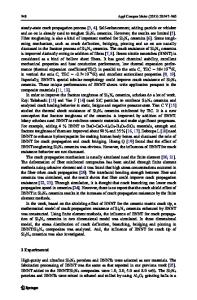Mechanical properties of hot isostatically pressed Si 3 N 4 and Si 3 N 4 /SiC composites
- PDF / 1,387,530 Bytes
- 9 Pages / 576 x 792 pts Page_size
- 83 Downloads / 436 Views
J. J. Petrovic Materials Science and Technology Division, Los Alamos National Laboratory, Los Alamos, New Mexico 87545
T. E. Mitchell Center for Materials Science, Los Alamos National Laboratory, Los Alamos, New Mexico 87545 (Received 11 May 1992; accepted 22 October 1992)
The mechanical properties of hot isostatically pressed monolithic Si 3 N 4 and S13N4-2O vol. % SiC composites have been studied by microindentation at temperatures up to 1400 °C. Indentation crack patterns and microstructures have been examined by optical microscopy, scanning electron microscopy, and transmission electron microscopy. It is shown that dense Si 3 N 4 base materials can be synthesized by HIPing without densification aids. Both the monolithic Si3N4 and the Si 3 N 4 /SiC composites exhibit high hardness values which gradually decrease with increasing temperature. Both types of material show low fracture toughness values apparently because of strong interfacial bonding. On the other hand, the fracture toughness of the composite is about 40% higher than that of the monolithic material, due to the presence of the 20 vol. % SiC whiskers. A crack deflection/debonding mechanism is likely to be responsible for the higher toughness observed in the composite. High resolution electron microscopy shows that the grain boundaries in both samples contain a thin SiO2 layer.
I. INTRODUCTION Dense silicon nitride (Si 3 N 4 ) is an important structural material for high temperature applications primarily due to its superior thermal shock resistance, high strength, and good resistance to oxidation, as compared to other structural materials.1 However, one of the problems associated with Si 3 N 4 is that densification is difficult because of the low self-diffusion coefficient of its constituents and the high degree of covalent bonding.2 Densification of Si 3 N 4 is usually carried out through the addition of metal oxides such as MgO, A12O3, and Y 2 O 3 . These sintering aids form a liquid phase at elevated temperatures and promote densification by means of solution-precipitation.1'3 The drawback of this practice, however, is that the liquid phase is retained as a glassy phase at the grain boundaries which softens at elevated temperatures, thus leading to degradation of mechanical properties. In order to avoid such degradation, several techniques have been successfully developed to densify Si3N4 to its theoretical density without additives by high pressure techniques such as hot isostatic pressing (HIPing).4"7 The high pressure has a beneficial effect on the control of the ultimate structure by lowering the
^Present address: Department of Materials Science and Engineering, Case Western Reserve University, Cleveland, Ohio 44106. 626 http://journals.cambridge.org
densification temperature, controlling grain growth, and preventing decomposition of the Si 3 N 4 . 8 Furthermore, uniform material properties are obtained by the uniform pressures applied during the HIPing process. Ceramics such as Si 3 N 4 are currently limited in their structural application
Data Loading...











